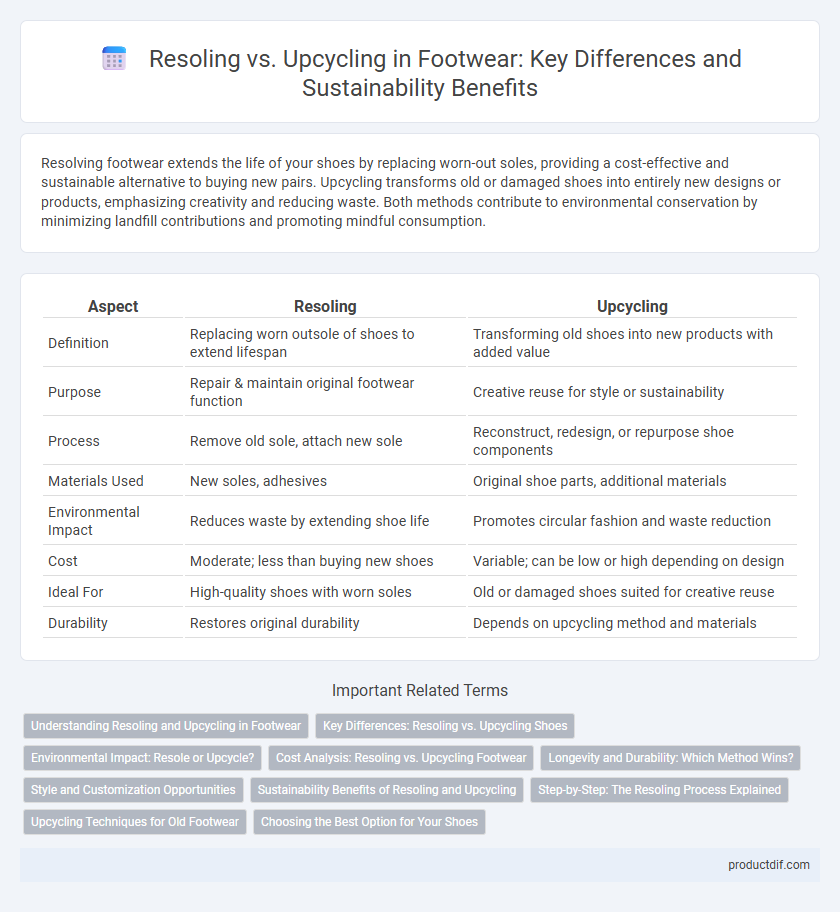Resolving footwear extends the life of your shoes by replacing worn-out soles, providing a cost-effective and sustainable alternative to buying new pairs. Upcycling transforms old or damaged shoes into entirely new designs or products, emphasizing creativity and reducing waste. Both methods contribute to environmental conservation by minimizing landfill contributions and promoting mindful consumption.
Table of Comparison
| Aspect | Resoling | Upcycling |
|---|---|---|
| Definition | Replacing worn outsole of shoes to extend lifespan | Transforming old shoes into new products with added value |
| Purpose | Repair & maintain original footwear function | Creative reuse for style or sustainability |
| Process | Remove old sole, attach new sole | Reconstruct, redesign, or repurpose shoe components |
| Materials Used | New soles, adhesives | Original shoe parts, additional materials |
| Environmental Impact | Reduces waste by extending shoe life | Promotes circular fashion and waste reduction |
| Cost | Moderate; less than buying new shoes | Variable; can be low or high depending on design |
| Ideal For | High-quality shoes with worn soles | Old or damaged shoes suited for creative reuse |
| Durability | Restores original durability | Depends on upcycling method and materials |
Understanding Resoling and Upcycling in Footwear
Resolving in footwear involves replacing worn-out soles to extend the shoe's lifespan, preserving its original structure while enhancing durability. Upcycling transforms old or discarded shoes into new, innovative designs, often combining creative materials to reduce waste and promote sustainability. Both practices contribute to environmentally conscious footwear by minimizing landfill impact and supporting circular fashion principles.
Key Differences: Resoling vs. Upcycling Shoes
Resolving shoes involves replacing the worn-out soles to restore functionality and extend the lifespan of the footwear, primarily targeting sole durability and comfort. Upcycling shoes transforms old or damaged footwear into entirely new designs or products, emphasizing creativity and sustainability by repurposing materials. The key difference lies in resolving maintaining the original shoe's structure while upcycling reimagines and reinvents the shoe's form and purpose.
Environmental Impact: Resole or Upcycle?
Resoling shoes extends their lifespan by replacing worn-out soles, significantly reducing landfill waste and conserving resources compared to buying new footwear. Upcycling transforms old shoes into new products or materials, preventing waste and lowering environmental impact by avoiding raw material extraction. Both practices contribute to sustainable footwear by minimizing carbon emissions and promoting circular economy principles.
Cost Analysis: Resoling vs. Upcycling Footwear
Cost analysis reveals that resoling footwear typically incurs lower expenses than upcycling due to fewer materials and labor involved. Resoling extends the shoe's life by replacing worn soles at an average cost of $30 to $60, while upcycling can range from $50 to over $100 because it often includes redesign and additional craftsmanship. Investing in resoling promises economic efficiency for maintaining footwear, whereas upcycling offers creative value but at a higher financial commitment.
Longevity and Durability: Which Method Wins?
Resolving extends footwear longevity by replacing worn soles, maintaining original structure and durability for sustained use. Upcycling enhances durability through creative repairs and material reinforcements, often improving style while preserving functionality. Resoling generally offers superior long-term durability, whereas upcycling provides customized longevity with environmental benefits.
Style and Customization Opportunities
Resoling offers a practical way to restore footwear functionality while preserving the original design, maintaining classic style lines favored by traditionalists. Upcycling transforms worn shoes into unique, customized pieces by incorporating new materials, patterns, or artistic elements, appealing to fashion-forward individuals seeking distinctive personalization. Both methods provide eco-conscious options but diverge in customization scope: resoling emphasizes maintaining original aesthetics, whereas upcycling encourages creative reinvention and style evolution.
Sustainability Benefits of Resoling and Upcycling
Resolving extends the lifespan of footwear by replacing worn soles, significantly reducing waste and the demand for new raw materials. Upcycling transforms old shoes into new products, minimizing landfill contributions and lowering the carbon footprint associated with manufacturing. Both practices promote circular economy principles, conserving resources and fostering eco-friendly consumption in the footwear industry.
Step-by-Step: The Resoling Process Explained
Resolving footwear begins with removing the worn outsole carefully to preserve the shoe's upper integrity. Next, a new sole is measured, cut, and shaped to match the original dimensions precisely, ensuring durability and comfort. The final steps involve attaching the sole using industrial-strength adhesives and stitching, followed by quality inspection to restore functionality and extend the shoe's lifespan.
Upcycling Techniques for Old Footwear
Upcycling techniques for old footwear transform worn-out shoes into stylish, functional pieces by incorporating materials like recycled rubber, fabric scraps, and natural dyes. Methods such as patchwork stitching, decorative painting, and sole replacement enhance durability while reducing environmental impact. Emphasizing creativity and sustainability, upcycling preserves original shoe components, extending their lifecycle and minimizing waste in the footwear industry.
Choosing the Best Option for Your Shoes
Resolving your shoes preserves their original structure by replacing worn soles, extending their lifespan with minimal environmental impact. Upcycling transforms old footwear into new, creative products, reducing waste and promoting sustainability. Selecting the best option depends on the shoe's condition, durability, and your commitment to eco-friendly practices.
Resoling vs Upcycling Infographic

 productdif.com
productdif.com